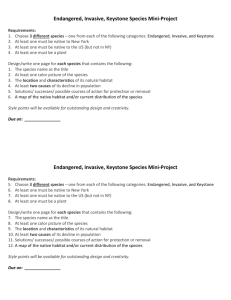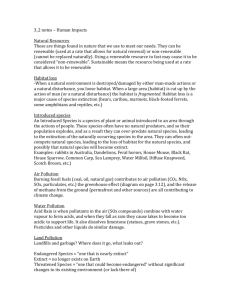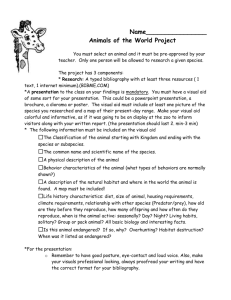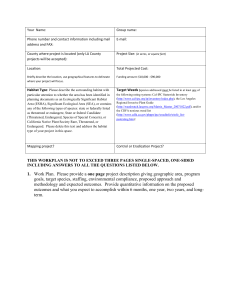A Call to Action - World Wide Waldens
advertisement
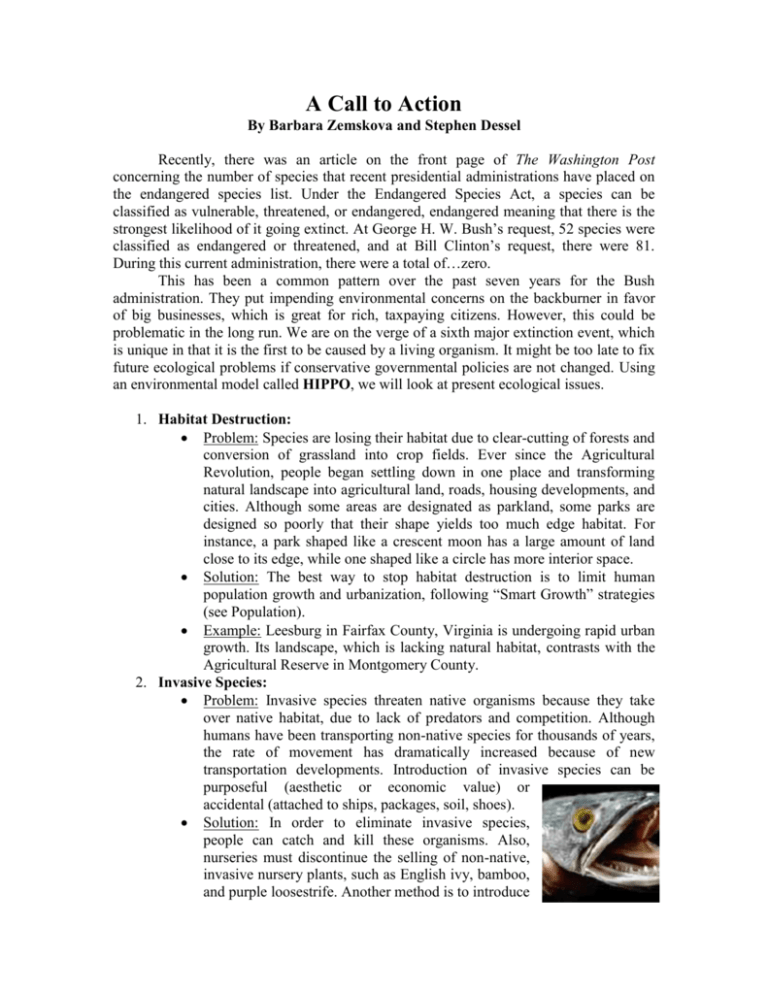
A Call to Action By Barbara Zemskova and Stephen Dessel Recently, there was an article on the front page of The Washington Post concerning the number of species that recent presidential administrations have placed on the endangered species list. Under the Endangered Species Act, a species can be classified as vulnerable, threatened, or endangered, endangered meaning that there is the strongest likelihood of it going extinct. At George H. W. Bush’s request, 52 species were classified as endangered or threatened, and at Bill Clinton’s request, there were 81. During this current administration, there were a total of…zero. This has been a common pattern over the past seven years for the Bush administration. They put impending environmental concerns on the backburner in favor of big businesses, which is great for rich, taxpaying citizens. However, this could be problematic in the long run. We are on the verge of a sixth major extinction event, which is unique in that it is the first to be caused by a living organism. It might be too late to fix future ecological problems if conservative governmental policies are not changed. Using an environmental model called HIPPO, we will look at present ecological issues. 1. Habitat Destruction: Problem: Species are losing their habitat due to clear-cutting of forests and conversion of grassland into crop fields. Ever since the Agricultural Revolution, people began settling down in one place and transforming natural landscape into agricultural land, roads, housing developments, and cities. Although some areas are designated as parkland, some parks are designed so poorly that their shape yields too much edge habitat. For instance, a park shaped like a crescent moon has a large amount of land close to its edge, while one shaped like a circle has more interior space. Solution: The best way to stop habitat destruction is to limit human population growth and urbanization, following “Smart Growth” strategies (see Population). Example: Leesburg in Fairfax County, Virginia is undergoing rapid urban growth. Its landscape, which is lacking natural habitat, contrasts with the Agricultural Reserve in Montgomery County. 2. Invasive Species: Problem: Invasive species threaten native organisms because they take over native habitat, due to lack of predators and competition. Although humans have been transporting non-native species for thousands of years, the rate of movement has dramatically increased because of new transportation developments. Introduction of invasive species can be purposeful (aesthetic or economic value) or accidental (attached to ships, packages, soil, shoes). Solution: In order to eliminate invasive species, people can catch and kill these organisms. Also, nurseries must discontinue the selling of non-native, invasive nursery plants, such as English ivy, bamboo, and purple loosestrife. Another method is to introduce its natural predators. However, these predators can cause more problems by becoming invasive species as well. Example: The snakehead fish was originally imported as an aquarium fish from China. However, several organisms escaped and now live in natural bodies of water. The snakehead fish feeds on native species of frogs, fish, and turtles, and transmits foreign parasites. 3. Pollution Problem: Several factors contribute to air, water, and soil pollution. Combustion of fossil fuels releases harmful gases, including carbon dioxide, carbon monoxide, sulfur, and nitrogen oxides. Not only do these gases contribute to the greenhouse effect and formation of photochemical smog, but they also cause acid rain that destroys some aquatic ecosystems. Pesticides affect immune, nervous, and reproductive systems of organisms, including humans. Solution: Scientists must find efficient alternative energy sources for our transportation that are renewable, and limit carbon dioxide emissions from industrial buildings. Humans are much too dependent on petroleum and coal, which pollute the environment and only exist in a limited amount. Harnessing energy from other sources, such as the sun, water, and wind, emits less carbon dioxide and is infinitely renewable. On a smaller scale, individuals can drive less, use environmentally friendly appliances, and even plant trees. Example: Mirant coal power plant in Dickerson, MD releases two tons of carbon dioxide for every ton of coal that is burnt. Particulates and greenhouse gas emissions significantly contribute to air pollution, especially because carbon dioxide emissions are difficult to capture. Other coal plants also put water back into waterways that is ten to twelve degrees warmer than it originally was. Such thermal pollution is harmful for aquatic ecosystems because the organisms cannot adjust to the rising water temperature. 4. Population (Human): Problem: Human population has already exceeded six billion, and it is projected to reach eight to ten billion by 2050. If humans continue to consume resources at the current rate, there will be a significant lack of food, water, and space, especially in the developing nations. Urbanization can lead to destruction of natural habitats, soil erosion, and pollution. Solution: The best way to limit overpopulation is to encourage effective family planning, especially in less developed countries. In order for family planning to be effective, a family must consider its financial status and the devastating impact of a large family on the environment. Family planning often does not occur in developing nations because of a lack of women’s rights and sheer ignorance. We must educate the poor in countries with rapidly increasing populations. Example: Montgomery County is an area experiencing rapid population growth; its population is currently around one million. New housing developments have emerged in remote areas of the county, such as Clarksburg, Damascus, and Poolesville. 5. Overharvesting: Problem: Technological advances improved fishing fleets and hunting equipment, allowing humans to harvest more than they need. In addition, fishermen often catch some unintended species that are stuck in the large nets. Occasionally, only some parts of the caught individuals are used, effectively wasting the life of an organism. Solution: The government can monitor fishing and hunting by enacting a more stringent licensing system. It can also hire more park rangers to prevent illegal poaching. Example: Crabbers in the Chesapeake Bay area are now required to obtain a license in order to crab. This regulation resulted from a considerable decrease in the crab population in the Bay due to overfishing. Shark fins are a delicacy in Chinese cuisine. Because shark meat itself is not valuable, fishermen cut off the fins and the tails, throwing the rest of the body overboard. To a teenager living in the United States, a potential environmental catastrophe may seem light years away. However, the need to change our ways has indeed never been more apparent. Many prominent politicians in government lack foresight; they only seem to enact policies designed to be beneficial right now. It is necessary not only to reduce one’s own impact on the environment, but also to convince the politicians that we need to change as a society. There is great concern that our procrastination in solving environmental problems may prove fatal. However, if every person on the planet does some small action for the wellbeing of the natural world, then the future of the environment will be a brighter one.
